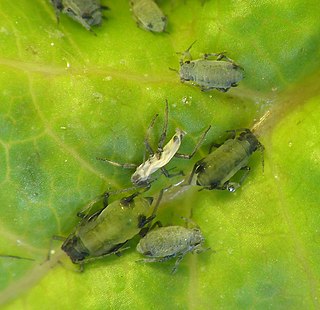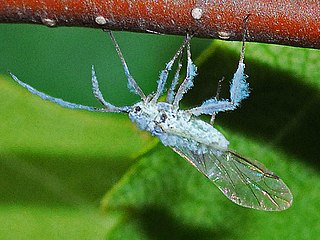Related Research Articles

Vaccinium myrtilloides is a shrub with common names including common blueberry, velvetleaf huckleberry, velvetleaf blueberry, Canadian blueberry, and sourtop blueberry. It is common in much of North America, reported from all 10 Canadian provinces plus Nunavut and Northwest Territories, as well as from the northeastern and Great Lakes states in the United States. It is also known to occur in Montana and Washington.

Glyphidocera is a genus of moths in the family Autostichidae.
Euleia fratria is a species of tephritid or fruit flies in the genus Euleia of the family Tephritidae. The species was first classified in 1862, and is native to North America. Adults have been reared from Angelica atropurpurea, Angelica hendersonii, Cicuta douglasii, and numerous other Apiaceae plants. Larvae are leaf miners, and may pupate within their host plant or in soil.

Ithonidae, commonly called moth lacewings and giant lacewings, is a small family of winged insects of the insect order Neuroptera. The family contains a total of ten living genera, and over a dozen extinct genera described from fossils. The modern Ithonids have a notably disjunct distribution, while the extinct genera had a more global range. The family is considered one of the most primitive living neuropteran families. The family has been expanded twice, first to include the genus Rapisma, formerly placed in the monotypic family Rapismatidae, and then in 2010 to include the genera that had been placed into the family Polystoechotidae. Both Rapismatidae and Polystoechotidae have been shown to nest into Ithonidae sensu lato. The larvae of ithonids are grub-like, subterranean and likely phytophagous.
Siamusotima is a genus of moths of the family Crambidae. The genus was erected by Maria Alma Solis et al. in 2005.

The genus Caliroa is a group of sawflies in the family Tenthredinidae. The larvae are slimy in appearance, and are sometimes referred to as "slugs" although they are insects rather than gastropods.
Ormocerus dirigoius is a species of stingless wasp. It is native to Maine, United States. It is likely a parasitoid of an oak gall wasp in the family Cynipidae. This species was found in bi-catch of samples collected for another research project.

Hyadaphis is a genus of aphids in the family Aphididae. There are about 19 described species in Hyadaphis.

Macrosiphum albifrons, the lupin aphid, is a species of large grey/ green aphid in the family Aphididae.

Periphyllus is a genus of maple aphids in the family Aphididae. There are more than 40 described species in Periphyllus.

Phyllaphis fagi, the woolly beech aphid, is a species of aphid in the family Aphididae.
Cerataphis is a genus of witch hazel and palm aphids in the family Aphididae. There are about 10 described species in Cerataphis.
Hayhurstia is a genus of aphids in the family Aphididae. There is one described species in Hayhurstia, H. atriplicis.
Sarucallis, also known by its common name as the Crape myrtle aphid or Kirkaldy, is a genus of aphids in the family Aphididae. There is one described species in the genus Sarucallis and it is Sarucallis kahawaluokalanu (S. kahawaluokalani). They can grow to a body length of 1.2 to 1.8 millimeters.

Capitophorus is a genus of aphids in the family Aphididae. There are more than 30 described species in Capitophorus.
Neophyllaphis is a genus of aphids in the family Aphididae. There are about 18 described species in Neophyllaphis.

Hyperomyzus is a genus of aphids in the family Aphididae. There are more than 20 described species in Hyperomyzus.
Siamusotima disrupta is a species of stem-boring moth of the family Crambidae first described by Maria Alma Solis et al. in 2017.

Tamalia is a genus of aphids in the family Aphididae. It is the only genus in the subfamily Tamaliinae. There are eight described species in Tamalia.

Hormaphis is a genus of witch hazel and palm aphids in the family Aphididae. There are at least three described species in Hormaphis, found mainly in eastern North America.